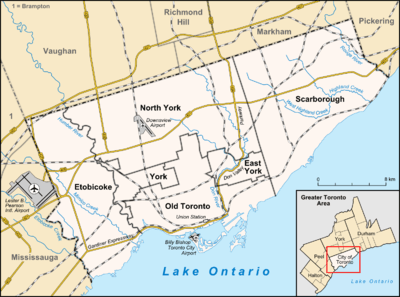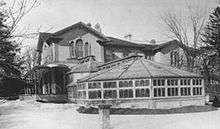Alexandra Park, Toronto
| Alexandra Park | |
|---|---|
| Neighbourhood | |
|
Buildings in Alexandra Park | |
|
| |
 Location within Toronto | |
| Coordinates: 43°39′N 79°24′W / 43.650°N 79.400°WCoordinates: 43°39′N 79°24′W / 43.650°N 79.400°W | |
| Country |
|
| Province |
|
| City |
|
| Government | |
| • MP | Adam Vaughan (Spadina-Fort York) |
| • MPP | Han Dong (Trinity—Spadina) |
| • Councillor | Joe Cressy (Ward 20 Trinity—Spadina) |
Alexandra Park is a neighbourhood located in downtown Toronto, Ontario, Canada. Alexandra Park is bounded by Dundas Street West on the north, Spadina Avenue on the east, Queen Street West on the south, and Bathurst Street on the west. Alexandra Park consists of private and public housing, with at grade retail along Queen Street West and Spadina Avenue, some institutional, and several commercial buildings scattered through the neighborhood. The neighborhood takes its name from Alexandra Park, a municipal park at the south-east corner of Dundas Street West and Bathurst Street. The park is named for Queen Alexandra, wife of King Edward VII, the first future monarch to visit Toronto.

History

The recorded history of the area begins with the original survey of the northern shore of Lake Ontario conducted by Augustus Jones in 1791. The survey established a baseline soon to be called Lot Street (later renamed Queen Street). The area now known as Alexandra Park was then the southern portions of lots 16, 17 and 18 of Concession 1 of the Township of York. When the City of Toronto was incorporated in 1834, it included the area 400 yards to the north of Queen Street, roughly the location of present day Grange Street. The remainder of the area was annexed by the city in 1859.
The area was purchased from the Denison family in 1841 by Sir Casimir Gzowski, a Polish engineer who built his grand home, which he called 'The Hall', at what is now the south-east corner of Dundas St. W. and Bathurst St. A neighbourhood sprang up around Gzowski's home that was inhabited largely by Polish and Ukrainian immigrants in the 1920s and 1930s. In the 1960s, 'The Hall' and many of the surrounding homes were demolished to make way for a public housing project.[1] The public housing projects brought in many immigrants from the Caribbean, East Africa, China and Vietnam. Alexandra Park is known for having one of the largest African Canadian communities in Toronto, and people of African American ancestry are still evident in this neighbourhood. In the 1970s and '80s, there were racial tensions between the established Polish and Ukrainian immigrants and the new immigrants. An infamous African Canadian gang called the Project Originals emerged. Drugs and violence were a huge problem, and during this time, a crack epidemic swept the area. In the early '90s, a group of Alexandra Park residents sought to convert the government housing complex to self-governing co-operative housing, in order to attempt to make a difference in the struggling community in an effort to stop the oppression and drug wars the project had been facing for many decades previous. Today Alexandra Park is recovering from its harsh battles in the past, and making an effort to turn a new leaf.
Future
After a long period of community consultation, The Toronto Community Housing Corporation has completed plans for a major revitalization of Atkinson Co-op and surrounding areas of Alexandra Park. TCHC submitted Official Plan Amendment and Rezoning applications on March 11, 2011 and held a community meeting on June 27, 2011 to present the plan to local residents. The plan envisages major changes to the neighborhood, phased in over a 15 year period. Several streets that were closed off when the complex was first constructed will be reopened. 333 townhouses and apartments will be demolished and replaced, while 473 units in the towers at 20 Vanauley Street, 91 Augusta Street and 71 Augusta Square will be renovated. 1540 units of market condominiums and townhouses will be added, with retail units on the south side of Dundas Street West. New public parks and private amenity spaces will also be added.[2]
Culture and recreation
Theatre Passe Muraille is located in the neighbourhood. The City of Toronto operates Alexandra Park swimming pool[3] while the Scadding Court Community Centre and the Charles R. Sanderson Memorial Branch of the Toronto Public Library[4] share a building on the grounds of Alexandra Park, part of Toronto's municipal park system. Scadding Court is also home to Alexandra Park Neighbourhood Learning Centre, an adult literacy program that offers Literacy Basic Skills (LBS) and Academic and Career Entrance (ACE) courses.[5] Alexandra Park also offers an outdoor skating rink in the winter, that is converted to a skateboard park in the summer. The skateboard park is nicknamed Dunbat Skate Park, referencing its location at the corner of Dundas Street West and Bathurst Street.
Demographics
Census tract 0039.00 of the 2006 Canadian census covers Alexandra Park. According to that census, the neighbourhood has 4,355 residents. Average income is $19,687, the second lowest average income in Toronto after Regent Park. The ten most common language spoken at home, after English, are:
- Cantonese - 17.9%
- Unspecified Chinese - 15.8%
- Mandarin - 5.9%
- Vietnamese - 4.1%
- Bengali - 1.5%
- French - 1.3%
- Somali - 1.1%
- Portuguese - 0.9%
- Tagalog - 0.7%
- Punjabi - 0.3%
Notes
- ↑ "Alexandra Park - History". Toronto Neighbourhoods. Maple Tree Publishing. 1999. Archived from the original on May 20, 2010. Retrieved 2008-12-12.
- ↑ "Alexandra Park Official Plan Amendment & Rezoning".
- ↑ "Toronto & East York District - Swimming Pools". City of Toronto. Retrieved 2008-12-12.
- ↑ "Sanderson Library (SA)". Hours and Locations. Toronto Public Library. Retrieved 2008-12-12.
- ↑ APNLC website
References
- "Topographic Map sheet 30M11". Atlas of Canada. Natural Resources Canada. 2006-02-06. Archived from the original on 22 January 2009. Retrieved 2008-12-12.
 |
Kensington Market |  | ||
| Trinity-Bellwoods | |
Chinatown | ||
| ||||
| | ||||
| Niagara |